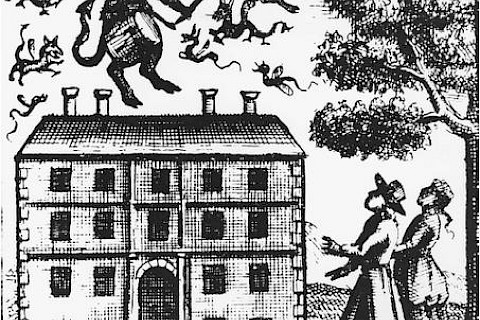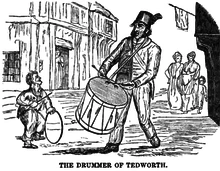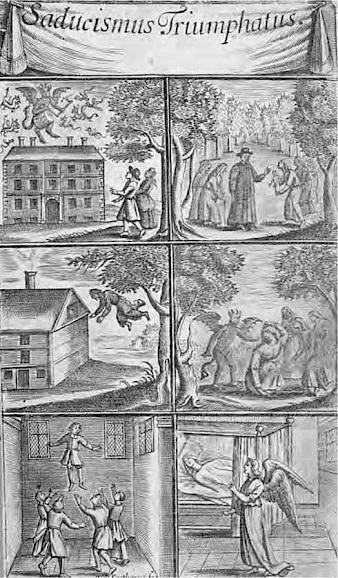

The Drummer of Tedworth
I am often jumping back and forward when it comes to research. I may research a topic for a while and then put it down and revisit it months/years later. A few years ago I started researching more into poltergeist activity and its origins In my search, I have come across an old ghost story thought to be an early account of poltergeist activity dating back to 1661. The story 'The Ghostly Drummer of Tedworth' appeared in the book Saducismus Triumphatus' by Joseph Gianvill published in English in 1681. A fascinating story I thought I would share. Interestingly, there are different accounts of this tale available as there were different versions of the book published over the years and the story itself also goes by different titles such as the 'Demon Drummer of Tedworth'. It is worth noting that some of the translations are interpreted differently. I tried to research as thoroughly as I could with this one and below is the version I believe to be truest to form as I have read what are believed to be original letters from those involved - and they are difficult to translate and understand at times. My version may possibly be incorrect in some places, but this is my interpretation of it. In the meantime grab a cup of tea and a block of chocolate and enjoy this old-school tale of terror.

In March of 1661, John Mompesson who was a Justice of the Peace had brought to him a drummer by the name of 'William Drury'. It seemed Mr Drury had been demanding money from people using a fake pass signed by Sir William Cawleys and Colonell Ayliffe. When presented to Mr Mompesson, he stated he knew these gentlemen and more importantly their writing well and deemed that the pass was in fact a fake. He seized his drum and asked the local Constable to take him to the next Justice of the Peace. He confessed to his crime and begged for his drum back. Mr Mompesson hearing the passionate pleas said that he would speak to Colonel Ayliffe (as Drury claimed he used to drum for him) to determine if he was an honest man but would not return his drum. He started demanding to have his drum back however Mr Mompesson told him to be grateful and move along.
The drum made its way into Mr Mompesson's private home in April where he left shortly after for a trip to London. When he returned, his wife told him of the strange happenings in the household. Loud noises were first thought by his wife as intruders trying to get into the house. On the 3rd evening after his return, Mr Mompesson started experiencing these noises himself. While asleep, he was quickly awoken by a loud knocking noise on a door. Inspecting with his trusty pistol in his hand, he opened the door to find no one on the other side. The knocking had now started on a different door. Again no one was there. He walked the perimeter of the house only to find no trace of any person causing these noises. He went back to bed and could hear what sounded like the noise of a drum beating - coming from inside his roof. Every night, just after they would retire to bed at night, the drumming noise could be heard. It didn't matter what time they went to bed be it early or late, it would start when they went to bed and they described it as an annoying lullaby. Eventually, the sound of the drumming made its way from being on the roof and eventually ended up in the room where the drum of Mr Drury was stored. Whatever was controlling the drum was at least a little bit considerate and took the night off when Mrs Mompesson gave birth to a child and kept silent for 3 weeks.

When the 3 weeks had passed, whatever was causing the drumming noises decided it was time to up the ante. Unfortunately, a lot of this was directed toward the children of the house. The ghostly drummer would loudly beat against their beds. On some occasions, he lied underneath the bed scratching the floor and even levitating the bed. They tried moving the children to different rooms, however, it made no difference. The drummer followed them wherever they went. By November, it was said that this force had become so strong that it could 'pass boards to the servants making repairs on the house' and was supposedly witnessed by many people. Some referred to it as a demon due to the 'sulphur' like smell that it would leave behind and said its origin must be 'from the pit of Hades'. The family consulted with the local Reverend who came over to do some prayers. The drumming was completely silent until the very last 'Amen'. Chairs started to fly across the room, the kid's shoes were thrown in the air and the Reverend was even injured by a stray staff that was thrown at his leg.
Neighbours reported that they could hear the banging noises of several houses up the street and the servants were not overlooked. The drummer tormented them too, always at night. At the beginning of 1862, it seemed the entity had found its voice and it would sing in the chimney and chant in the kid's room 'I'm a witch'. One night Mr Mompesson claimed it took the form of an invisible dog and ran next to his bedside at night panting. He must have had a little bit of paranormal investigator in him as the next night he took ashes from the fireplace and spread them on the floor to see if any footprints would appear. He awoke the next day to find claw-like footprints, some words and drawings all written in the ashes. Reverend Joseph Glanvill was then called in (Yes the author), and the spirit was very cooperative with the Reverend and gave him all the proof he needed of their existence. He tried to debunk the occurrences and find a natural explanation and was not able to do so. The proof was in the pudding for him when he saw a linen bag moving on its own. Thinking a mouse or rat must be inside he picked it up to find it completely empty. The Reverend and his friend retired for the night and of course, the knocking started. They asked the knocking what it wanted with them to which it got the reply 'nothing'. The next day when the Reverend went to leave, his horse seemed distressed like it had been ridden all night. The horse collapsed when he tried to leave and died 2 days later.
The activity seemed to increase and again was focused on the kids. The chants of 'I am a witch' grew stronger in their bedroom and even the baby was not spared and was not allowed to sleep. One night, it seemed a piece of firewood had a life of its own. Mr Mompesson shot it with his pistol and was surprised to see the wood bleed as if it was wounded. They had 3 nights of peace until the entity returned again healed and more violent than ever. He organized for his kids to stay with a friend. Not having the kids to focus on, the entity turned its attention to a servant and showed its 'true form' to him. He described the entity to have a 'great body with red eyes'.
While all of this was happening, Mr Drury was locked up in a gaol in Gloucester. It is there that he confessed to using 'Witchcraft' on Mr Mompesson as a form of punishment that would not stop until he was satisfied. All because he took away his most treasured item - his drum. Mr Mompesson then had him tried for witchcraft. There are stories that the Captain and crew who were supposed to transport Mr Drury by boat to sit at his trial were scared and turned the boat around as they felt Mr Drury had conjured storms. People were scared to be around Mr Drury as remember back in this time, Witchcraft was thought to be a very real thing. Eventually, the Kings commission came to investigate the case. They could not convict Mr Drury as they did not witness any of the phenomena that had been occurring for the last 2 years. They felt it was either a hoax or caused by a natural phenomenon.
The end of this story is concluded with a thought that still rings very true today centuries later. The general theme of it was, just because they didn't witness anything while they were there, doesn't mean that it didn't happen.
References
Historic ghosts and ghost hunters by H Addington Bruce (1908)
Saducismus triumphatus by Joseph Glanvill (1681)
If you enjoy LLIFS, consider buying me a book (otherwise known as buy me a coffee but I don't drink coffee and I LOVE books). Your donation helps to fund the LLIFS website so everyone can continue to access great paranormal content and resources for FREE!

Top pages with similar subjects
Don't forget to follow the Facebook page for regular updates
Join the mailing list to receive weekly updates of NEW articles. Never miss an article again!
Buy the latest and past issues Haunted Magazine
Check out the books written by LLIFS